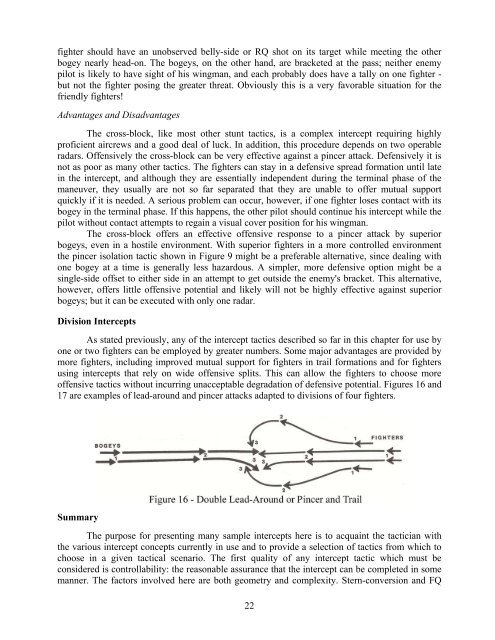Tactical Intercepts.pdf - e-HAF
Tactical Intercepts.pdf - e-HAF
Tactical Intercepts.pdf - e-HAF
Create successful ePaper yourself
Turn your PDF publications into a flip-book with our unique Google optimized e-Paper software.
fighter should have an unobserved belly-side or RQ shot on its target while meeting the other<br />
bogey nearly head-on. The bogeys, on the other hand, are bracketed at the pass; neither enemy<br />
pilot is likely to have sight of his wingman, and each probably does have a tally on one fighter -<br />
but not the fighter posing the greater threat. Obviously this is a very favorable situation for the<br />
friendly fighters!<br />
Advantages and Disadvantages<br />
The cross-block, like most other stunt tactics, is a complex intercept requiring highly<br />
proficient aircrews and a good deal of luck. In addition, this procedure depends on two operable<br />
radars. Offensively the cross-block can be very effective against a pincer attack. Defensively it is<br />
not as poor as many other tactics. The fighters can stay in a defensive spread formation until late<br />
in the intercept, and although they are essentially independent during the terminal phase of the<br />
maneuver, they usually are not so far separated that they are unable to offer mutual support<br />
quickly if it is needed. A serious problem can occur, however, if one fighter loses contact with its<br />
bogey in the terminal phase. If this happens, the other pilot should continue his intercept while the<br />
pilot without contact attempts to regain a visual cover position for his wingman.<br />
The cross-block offers an effective offensive response to a pincer attack by superior<br />
bogeys, even in a hostile environment. With superior fighters in a more controlled environment<br />
the pincer isolation tactic shown in Figure 9 might be a preferable alternative, since dealing with<br />
one bogey at a time is generally less hazardous. A simpler, more defensive option might be a<br />
single-side offset to either side in an attempt to get outside the enemy's bracket. This alternative,<br />
however, offers little offensive potential and likely will not be highly effective against superior<br />
bogeys; but it can be executed with only one radar.<br />
Division <strong>Intercepts</strong><br />
As stated previously, any of the intercept tactics described so far in this chapter for use by<br />
one or two fighters can be employed by greater numbers. Some major advantages are provided by<br />
more fighters, including improved mutual support for fighters in trail formations and for fighters<br />
using intercepts that rely on wide offensive splits. This can allow the fighters to choose more<br />
offensive tactics without incurring unacceptable degradation of defensive potential. Figures 16 and<br />
17 are examples of lead-around and pincer attacks adapted to divisions of four fighters.<br />
Summary<br />
The purpose for presenting many sample intercepts here is to acquaint the tactician with<br />
the various intercept concepts currently in use and to provide a selection of tactics from which to<br />
choose in a given tactical scenario. The first quality of any intercept tactic which must be<br />
considered is controllability: the reasonable assurance that the intercept can be completed in some<br />
manner. The factors involved here are both geometry and complexity. Stern-conversion and FQ<br />
22
















